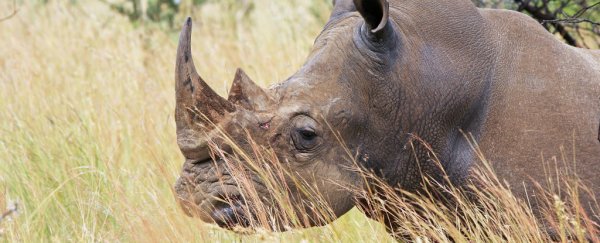South Africa has a major rhino poaching problem. According to conservation organisation, Save the Rhino, 5,940 African rhinos have been killed for their horns since 2008, and that number keeps rising, despite efforts to stop the illegal activity. With no end in sight, a new project will relocate 80 rhinos from South Africa to safari parks in Australia. Basically, rhinos are becoming refugees.
The project, aptly named the Australian Rhino Project, aims to create a small population of rhinos in Australia as a "biological backup" in case the situation in South Africa pushes local rhinos to extinction.
The first step, which will take place in May 2016, is to keep the first six rhinos in quarantine in Johannesburg for two months. Then, the rhinos will get flown to Taronga Western Plans Zoo, where they will undergo another two months of quarantine.
After their four-ish month stay in quarantine, the animals will get relocated to Monarto Zoo's safari park in Adelaide, South Australia. Over the next four years, the team hopes to relocate a total of 80 rhinos.
The move comes as researchers are realising that there is simply no longer a safe place to keep the endangered animals in Africa anymore.
As the project's founder, Ray Dearborn, puts it: "There is no safe place in Africa for rhinos today. They've become extinct pretty much from the top down to South Africa where probably 85 to 90 percent of the white and black southern rhinos that are left in the world."
So what's driving all this poaching in the first place? In one word: superstition. There's a huge market for rhino horn in China and Vietnam, where some believe it can cure a wide range of ailments from cancer to colds, reports the ABC.
In fact, the demand for rhino horn is so high, that a single one can cost upwards of US$500,000. With so much money on the line, it's no surprise that poachers go to great lengths to acquire them.
The most common way is for poachers to simply get tipped off where a group of rhinos are, gather a small team, and race across borders to kill the largest ones they can. Once completed, they flee to other countries, which makes it really difficult to pursue them. The horn then gets shipped off for sale in Asia.
Unless the market for their horn drops off immediately, rhinos are not safe anywhere in Africa. The project hopes to mitigate this by moving the animals far enough away that poachers will not be able to get to them.
Only time will tell if the white and black rhino populations can start to rebound in their new home. But the real goal is to end poaching and, therefore, the biggest factor standing in the way of the species' survival.
You can find out more about the project on the team's site.
